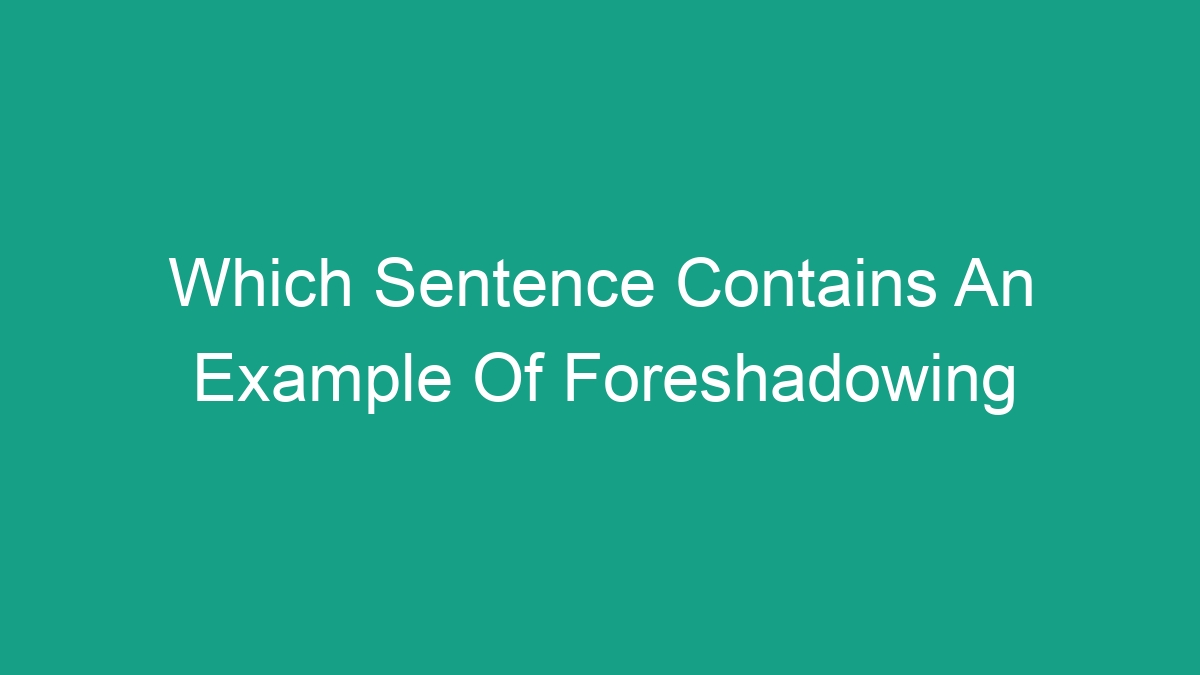
Understanding Foreshadowing
Foreshadowing is a literary device used by authors to hint at events that will happen later in the story. This technique creates suspense and anticipation in the reader, as they try to piece together the clues to predict future outcomes. Foreshadowing can take many forms, from subtle hints to more direct references to upcoming events. It adds depth and complexity to the narrative, engaging the reader on a deeper level.
Identifying Foreshadowing in Literature
When trying to identify foreshadowing in a story, it’s important to look for key elements that may hint at future events. These can include:
- Symbols: Objects, colors, or motifs that are repeated throughout the story and may take on a deeper meaning as the plot unfolds.
- Dialogue: Characters may unknowingly drop hints about the future or make cryptic statements that become significant later on.
- Events: Certain events or occurrences in the story may hint at larger, more impactful events to come.
- Character Behavior: The actions and behaviors of characters may foreshadow their future decisions or the direction of the plot.
By paying attention to these elements, readers can better understand and appreciate the use of foreshadowing in literature.
Examples of Foreshadowing in Literature
Foreshadowing is a common literary technique used in various works of literature. Here are some examples of sentences that contain foreshadowing:
- “The leaves on the trees shivered in the wind, as if anticipating the coming storm.” – This sentence uses the imagery of shivering leaves to foreshadow an impending weather event or a metaphorical “storm” of events or conflicts.
- “She had a sinking feeling in her stomach, a foreboding sense of dread that something terrible was about to happen.” – The use of “sinking feeling” and “foreboding sense of dread” serves as foreshadowing for an upcoming negative event or twist in the plot.
- “As the sun dipped below the horizon, casting long shadows across the landscape, he knew that darkness was approaching.” – In this sentence, the setting of the sun and the onset of darkness foreshadow a shift in the narrative towards a more ominous and intense atmosphere.
- “The old man’s warnings went unheeded, but little did they know, his words held the key to their fate.” – This sentence sets up the foreshadowing of the old man’s warnings being crucial to the characters’ future outcomes, creating a sense of impending doom or consequence.
Importance of Foreshadowing
Foreshadowing serves several important purposes in literature, including:
- Building Suspense: By hinting at future events, foreshadowing builds tension and anticipation for the reader, keeping them engaged with the narrative.
- Enhancing Plot Complexity: Foreshadowing adds layers of depth and complexity to the plot, providing a sense of cohesion in the storytelling.
- Engaging the Reader: Readers enjoy unraveling the clues provided through foreshadowing, as it allows them to participate in the storytelling process.
- Creating Emotional Impact: Foreshadowing can elicit emotional responses from readers, especially when they realize the significance of previously subtle hints.
How Writers Use Foreshadowing
Writers employ various techniques to incorporate foreshadowing into their writing, including:
- Symbols and Motifs: Using recurring symbols or motifs that develop into larger, more significant elements in the story.
- Subtle Clues: Dropping subtle hints and clues throughout the narrative that gain importance as the story progresses.
- Irony: Introducing ironic situations or statements that foreshadow events with unexpected outcomes.
- Character Insights: Revealing insights into characters’ thoughts, feelings, and motivations that hint at their future actions.
FAQs
1. How can I identify foreshadowing in a story?
To identify foreshadowing in a story, pay attention to recurring symbols, repeated dialogue, significant events, and character behaviors. These elements often contain clues that hint at future developments in the plot.
2. Why do authors use foreshadowing?
Authors use foreshadowing to create suspense, add complexity to the plot, engage the reader, and create emotional impact. It enhances the storytelling experience and allows for deeper engagement with the narrative.
3. Can foreshadowing be subtle or more direct?
Yes, foreshadowing can take many forms, from subtle hints that readers may not notice until a later re-reading, to more direct references that clearly point to future events in the story.


